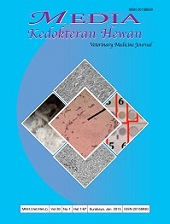Antimicrobial Resistance of Enterobacteriaceae Isolates from Chicken Eggs Sold at Bukidnon, Philippine
Downloads
The isolation of Enterobacteriaceae from chicken eggs and their antimicrobial resistance was investigated. The study utilized various selective, differential, and biochemical media for the isolation and identification of the organisms. The Kirby-Bauer disk diffusion method was then used to assess resistance to four commonly used antimicrobials. Results were interpreted based on reference values set by the Clinical Laboratory Standards Institute. A total of 101 Enterobacteriaceae organisms, including Citrobacter spp., Escherichia coli, Enterobacter spp., Klebsiella spp., Proteus spp., Salmonella spp., Serratia spp., and Shigella spp., were identified from eggshell surfaces and egg contents. In decreasing order of the number of resistant isolates, the bacterial isolates showed resistance to ampicillin, followed by trimethoprim-sulfamethoxazole, ciprofloxacin, and doxycycline. Multidrug resistance patterns were observed, with numerous representative bacterial isolates showing resistance to all antimicrobials. The findings highlight a public health concern and underscore the need for enhanced monitoring of antimicrobial-resistant bacteria in food sources, the judicious use of antimicrobials in poultry layer production, improved hygiene practices in food production and handling, and recommendations for further research to better understand resistance mechanisms.
Al-Bahry, S.N., Mahmoud, I.Y., Al-Musharafi, S.K., and Al-Ali, M.A., 2012. Penetration of spoilage and food poisoning bacteria into fresh chicken egg: a public health concern. GJBB, 1(1), pp.33–39.
Amer, M.M., Dahshan, A.H.M., Hassan, H.S., and Mohamed, A.A., 2013. Studies on the prevalence of Enterobacteriaceae in chickens and chicken eggs. J.Vet.Med.Res., 1(22), pp.136–144.
Bai, X., Nakatsu, C.H., and Bhunia, A.K., 2021. Bacterial biofilms and their implications in pathogenesis and food safety. Foods, 10:21117.
Barroga, T.R.M., Morales, R.G., Benigno, C.C., Castro, S.J.M., Caniban, M.M., Cabullo, M.F.B., Agunos, A., de Balogh, K., and Dorado-Garcia, A., 2020. Antimicrobials used in backyard and commercial poultry and swine farms in the Philippines: a qualitative pilot study. Front.Vet.Sci., 7:329.
Cheesbrough, M. 2006. District Laboratory Practice in Tropical Countries. 2nd Ed. London English Language Book Society. London.
Chousalkar, K.K., Flynn, P., Sutherland, M., Roberts, J.R., and Cheetham, B.F., 2010. Recovery of Salmonella and Escherichia coli from commercial egg shells and effect of translucency on bacterial penetration in eggs. Int.J.Food Microbiol., 142(1–2), pp.207–213.
Cook, M.I., Beissinger, S.R., Toranzos, G.A., and Arendt, W.J., 2005. Incubation reduces microbial growth on eggshells and the opportunity for trans‐shell infection. Ecol.Lett, 8(5), pp.532–537.
De Reu, K. 2006. Bacteriological contamination and infection of shell eggs in the production chain. Thesis. Faculty of Bioscience Engineering, University of Ghent.
Farmer, J.J., Farmer, M.K., and Holmes, B., 2010. Topley & Wilson's Microbiology and Microbial Infections. John Wiley and Sons, Ltd. New Jersey.
Feddern, V., De Prá, M.C., Mores, R., da Silveira Nicoloso, R., Coldebella, A., and de Abreu, P.G., 2017. Egg quality assessment at different storage conditions, seasons and laying hen strains. Ciênc.Agrotec., 41(3), pp.322–333.
Gong, H., Ma, Y., Wang, M., Gu, Y., Deng, R., Deng, B., Feng, D., Han, Y., Mi, R., Huang, Y., Zhang, Y., Zhang, W., and Chen, Z., 2023. Microbiota profiles of hen eggs from the different seasons and different sectors of Shanghai, China. Microorganisms, 11(10), pp.2519.
Islam, M., Sabrin, M.S., Kabir, M.H.B., and Aftabuzzaman, M., 2018. Antibiotic sensitivity and resistant pattern of bacteria isolated from table eggs of commercial layers considering food safety issue. AJMBR, 4(4), pp.323–329.
Jambalang, A.R., Buys, B.M., and Botha, F.S., 2017. Bacterial species from retailed poultry eggs in Tshwane, South Africa: implication for consumers. S.Afr.J.Sci., 113(11/12), pp.1-7.
Kathi, S. 2024. ESKAPE Pathogens. Springer Nature Singapore. Singapore.
Kilonzo-Nthenge, A., Nahashon, S.N., Godwin, S., Liu, S., and Long, D., 2016. Prevalence and antimicrobial resistance of Enterobacteriaceae in shell eggs from small-scale poultry farms and farmers' markets. J.Food Prot., 79(12), pp.2031–2037.
Kowalczyk, J., Czokajło, I., Gańko, M., Śmiałek, M., and Koncicki, A., 2022. Identification and antimicrobial resistance in Klebsiella spp. isolates from turkeys in Poland between 2019 and 2022. Animals, 12(22), 3157.
Mahdavi, M., Jalali, M., Safaei, H., and Shamloo, E., 2012. Microbial quality and prevalence of Salmonella and Listeria in eggs. Int.J.Environ.Health Eng., 1(1): 48.
Mahon, C.R. and Lehman, D.C., 2022. Textbook of Diagnostic Microbiology. 7th Ed. Elsevier Health Sciences. India.
Marshall, B.M. and Levy, S.B., 2011. Food Animals and Antimicrobials: Impacts on Human Health. Clin.Microbiol.Rev., 24(4), pp.718–733.
Musgrove, M.T., Jones, D.R., Northcutt, J.K., Cox, N.A., and Harrison, M.A., 2004. Identification of Enterobacteriaceae from washed and unwashed commercial shell eggs. J.Food Prot., 67(11), pp.2613–2616.
Musgrove, M.T., Northcutt, J.K., Jones, D.R., Cox, N.A., and Harrison, M.A., 2008. Enterobacteriaceae and related organisms isolated from shell eggs collected during commercial processing. Poult.Sci., 87(6), pp.1211–1218.
Okorie-Kanu, O.J., Ezenduka, E.V., Okorie-Kanu, C.O., Ugwu, L.C., and Nnamani, U.J., 2016. Occurrence and antimicrobial resistance of pathogenic Escherichia coli and Salmonella spp. in retail raw table eggs sold for human consumption in Enugu state, Nigeria. Vet. World, 9(11), pp.1312–1319.
Smith, A., Rose, S.P., Wells, R.G., and Pirgozliev, V., 2000. The effect of changing the excreta moisture of caged laying hens on the excreta and microbial contamination of their egg shells. Br.Poult.Sci., 41(2), pp.168–173.
Stepień-Pyśniak, D. 2010. Occurrence of Gram-negative bacteria in hens' eggs depending on their source and storage conditions. Pol.J.Vet.Sci, 13(3):507.
Theron, H., Venter, P., and Lues, J.F.R., 2003. Bacterial growth on chicken eggs in various storage environments. Food Res.Int., 36(9–10), pp.969–975.
Wales, A., Taylor, E., and Davies, R., 2022. Review of food grade disinfectants that are permitted for use in egg packing centres. World’s Poult.Sci.J., 78(1), pp.231–260.
Weinstein, M.P. 2019. Performance standards for antimicrobial susceptibility testing. 30th Ed. Clinical and Laboratory Standards Institute. USA.
Zhao Ge, Z.G., Song Xue, S.X., Zhao JianMei, Z.J., Li YuEhua, L.Y., Wang Juan, W.J., Huang XiuMei, H.X., Qu ZhiNa, Q.Z., Wang YuDong, W.Y., Yan ShiGan, Y.S., and Wang JunWei, W.J., 2016. Isolation, identification, and characterization of foodborne pathogens isolated from egg internal contents in China. J.Food Prot., 79(12), pp.2107–2112.
Copyright (c) 2025 Philip John Sajol, Rose Pearl S. Tanutan, Jhay Bonn Mark C. Torres, Vingelle Bautista Jimenez, Maria Lebeña Montemayor, Jose Jr. Obedencio

This work is licensed under a Creative Commons Attribution-ShareAlike 4.0 International License.

Veterinary Medicine Journal by Unair is licensed under a Creative Commons Attribution-ShareAlike 4.0 International License.
1. The Journal allows the author to hold the copyright of the article without restrictions.
2. The Journal allows the author(s) to retain publishing rights without restrictions
3. The legal formal aspect of journal publication accessibility refers to Creative Commons Attribution Share-Alike (CC BY-SA).





11.jpg)







11.png)













